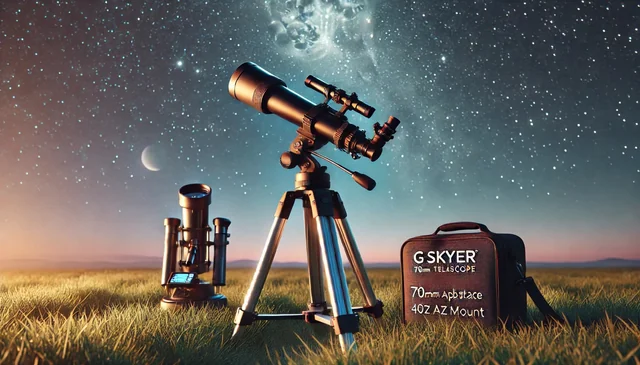Introduction to Gskyer Telescopes
Gskyer telescope have become increasingly popular among amateur astronomers and stargazing enthusiasts, particularly for their affordability, ease of use, and quality. Known for delivering reliable, high-quality optics at competitive prices, Gskyer has carved out a niche, especially with models designed for beginners. Many users appreciate the brand’s approach to making astronomy accessible without needing to spend a fortune or handle overly complex equipment.
Whether you’re interested in casual stargazing or delving into deep-sky exploration, a Gskyer telescope offers an entry point that balances performance with ease of use. Let’s dive into the essentials of what makes these telescopes so appealing and how to get the most out of your Gskyer telescope experience.
Types of Gskyer Telescopes
Gskyer offers several types of telescopes that cater to different viewing needs and experience levels. Here’s a closer look at the three primary types available:
Refractor Telescopes
Refractor telescopes are the most common type in Gskyer’s lineup. They use lenses to gather and focus light, making them ideal for observing planets, the moon, and other celestial bodies with high detail. Refractors are generally easy to maintain and require minimal adjustment.
Reflector Telescopes
Reflector telescopes use mirrors instead of lenses to gather light, allowing them to provide brighter images for the same aperture size compared to refractors. Reflectors are great for deep-sky observations, such as nebulae and galaxies, and are a good choice for those who want a larger telescope for an affordable price.
Compound Telescopes
Gskyer also offers compound telescopes, which blend elements of both refractors and reflectors. These telescopes are highly versatile and compact, offering the benefits of high magnification along with a wide field of view. They’re a solid choice for both terrestrial and celestial viewing.
Features of Gskyer Telescopes
Gskyer telescopes come equipped with various features that make them a solid choice for new and intermediate astronomers alike. Here are a few key specifications to consider:
Aperture and Focal Length
The aperture, which is the diameter of the telescope’s primary lens or mirror, determines the amount of light the telescope can gather. Gskyer offers telescopes with different aperture sizes that cater to various needs—from entry-level models with smaller apertures to more powerful models designed for serious stargazing. Focal length, on the other hand, affects magnification and field of view, allowing you to see objects in greater detail.
Lens Quality and Coatings
Gskyer telescopes are known for their quality optics. Many models come with multi-coated lenses, which reduce glare and improve image clarity. This attention to optical quality makes Gskyer telescopes an excellent choice for clear and bright images.
Mount Types and Stability
Gskyer telescopes are often equipped with either alt-azimuth or equatorial mounts. Alt-azimuth mounts are straightforward and user-friendly, suitable for beginners. Equatorial mounts, while requiring some practice to set up, allow smoother tracking of celestial objects as they move across the sky.
Popular Gskyer Telescope Models
Several Gskyer models stand out for their quality and affordability. Here’s an overview of some of the most popular options:
Gskyer AZ70400
The Gskyer AZ70400 is a 70mm refractor telescope that’s ideal for beginners. With a user-friendly alt-azimuth mount and a lightweight design, it’s perfect for taking on outdoor adventures. This model is highly portable, making it a favorite for both celestial and terrestrial observations.
Gskyer EQ901000
A step up from the AZ70400, the Gskyer EQ901000 offers a 90mm aperture and comes with an equatorial mount for more precise tracking. This model is suitable for those who want to experiment with astrophotography or observe faint objects in the night sky.
Gskyer 80mm Refractor
The Gskyer 80mm Refractor provides a good balance between portability and power. With an 80mm aperture, it’s well-suited for viewing both planets and some deep-sky objects. This model also offers easy assembly, making it popular with hobbyists who value convenience.
How to Choose the Right Gskyer Telescope for Your Needs
Selecting the right telescope depends on your experience, viewing goals, and budget. Here’s how to choose:
Age and Experience Level
If you’re new to astronomy, starting with a smaller, easier-to-use refractor telescope like the AZ70400 may be best. More experienced users might prefer a reflector or compound model that allows for more exploration of deep-sky objects.
Observing Goals
Determine if you’re more interested in close-up lunar and planetary views or if you’d like to delve into deep-sky objects like galaxies and nebulae. For lunar and planetary viewing, refractor models work well; for deeper space, a reflector or larger aperture telescope is ideal.
Budget Considerations
Gskyer telescope are affordable, but prices vary based on features and specifications. Setting a budget beforehand will help narrow your options and find the best telescope within your price range.
Setting Up Your Gskyer Telescope for the First Time
Setting up a Gskyer telescope is straightforward, especially with their beginner-friendly models. Here’s how to do it:
Unboxing and Initial Assembly
Carefully unbox each part of your telescope and lay it out. Most Gskyer telescopes come with a tripod, optical tube, eyepieces, and mount. Following the instruction manual, start with the tripod setup and then attach the mount securely.
Attaching the Telescope to the Mount
Once the mount is secured, attach the optical tube. For models with a dovetail mount, this process is usually quick and easy. Tighten any screws or bolts to ensure the telescope stays steady during use.
Calibrating and Aligning
Before your first stargazing session, align the telescope by adjusting the finderscope. Use a distant object, like a tree or building, to get it centered. Once aligned, your telescope will be easier to point accurately at night-sky objects.
Getting to know the basic specifications of your Gskyer telescope can help you achieve the best views possible. Let’s take a look at some important specs you’ll encounter:
Magnification Capabilities
Magnification is the measure of how much closer the telescope can bring distant objects to your view. While Gskyer telescopes often provide a range of magnification options through interchangeable eyepieces, remember that higher magnification does not always mean better clarity. Optimal magnification is a balance between the telescope’s aperture and the object being observed.
Field of View
The field of view (FOV) is the extent of the sky visible through the eyepiece. Larger FOVs are helpful for finding and observing wide regions of the sky, like star clusters or the Milky Way. Narrower fields of view are ideal for focusing on specific details of planets or the moon. Selecting the right eyepiece can help tailor your FOV depending on what you’re observing.
Light-Gathering Ability
Light-gathering ability is perhaps the most important factor, especially for night-sky observations. This capacity is primarily determined by the aperture: the larger the aperture, the more light the telescope gathers, resulting in brighter and clearer images. Gskyer’s entry-level models have smaller apertures, making them best for viewing bright objects like the moon, while higher-end models provide enough light-gathering power to reveal dimmer objects like distant galaxies.
Using Your Gskyer Telescope: Tips for Beginners
Gskyer telescopes are known for their simplicity, but a few tips can enhance your experience, especially if you’re new to stargazing.
Focusing Techniques
When you first look through the eyepiece, the view may be blurry. Use the focus knobs to bring objects into sharp view. Begin by focusing on a bright, visible object like the moon. Fine-tune your focus slowly to get the best clarity, and remember that atmospheric conditions (like humidity or air turbulence) can affect focus as well.
Adjusting the Mount for Stability
A stable mount is essential for a clear view. Make sure your tripod is on firm ground, and if necessary, add weights to stabilize it further. Even the slightest vibrations can blur your view, so make sure the mount is well-secured before you begin stargazing.
Choosing Eyepieces for Best Views
Gskyer telescopes typically come with a few eyepieces that offer different magnifications. Lower magnification eyepieces provide a wider field of view, making it easier to locate objects, while higher magnifications are better for zooming in on details. Start with a low magnification eyepiece to find your target and switch to a higher one once you have it in sight.
Night Sky Observing Tips with Gskyer Telescopes
Observing the night sky is all about planning and patience. Here’s how to make the most of your viewing experience with your Gskyer telescope.
Locating Planets and Stars
A basic star chart or smartphone astronomy app can help you identify visible planets and stars. Start with bright, easy-to-spot planets like Venus, Jupiter, or Saturn, which are among the most rewarding targets due to their distinctive features. Use low magnification to locate them, then gradually increase the zoom to reveal details like Jupiter’s moons or Saturn’s rings.
Observing the Moon
The moon is one of the most impressive celestial objects to observe, especially during its waxing and waning phases. During these phases, shadows cast by mountains and craters become more visible, offering breathtaking details. For the best views, avoid full moon nights when the moon’s brightness can be overwhelming.
Viewing Deep-Sky Objects
For a challenge, try locating deep-sky objects like star clusters, nebulae, and galaxies. Darker skies away from city lights are essential for these faint objects, and larger apertures work best. The Gskyer EQ901000 or 80mm Refractor models are better suited for deep-sky objects than smaller models like the AZ70400.
Gskyer Telescope Accessories
Accessories can enhance your Gskyer telescope experience, providing versatility and functionality. Here are some recommended add-ons:
Additional Eyepieces and Filters
Investing in a few extra eyepieces with varying focal lengths can expand your telescope’s versatility. Filters are also a great addition—moon filters reduce brightness when viewing the moon, while colored filters can bring out details on planets.
Smartphone Mounts and Adapters
For those interested in astrophotography, a smartphone mount allows you to attach your phone to the telescope, enabling you to capture images of celestial objects. This setup is ideal for beginners who want to take simple photos without investing in specialized cameras.
Travel Cases and Protective Covers
A travel case is essential if you plan to take your telescope outdoors. It keeps the equipment safe from damage during transportation. Protective covers can shield your telescope from dust and debris, helping to extend its lifespan and maintain lens clarity.
Common Issues and Troubleshooting for Gskyer Telescopes
Even the best telescopes can encounter occasional issues. Here’s a look at some common problems and solutions:
Blurry Images
If images appear blurry, check your focus settings first. Also, make sure the eyepiece and lenses are clean. Blurriness can also be caused by excessive magnification, so try using a lower magnification eyepiece to see if the image improves.
Mount Stability Problems
Unstable mounts can result in shaky views. Make sure the tripod legs are fully extended and positioned on level ground. You can also add a weight bag or place small sandbags on the tripod’s base to reduce vibrations.
Focusing and Alignment Issues
If alignment is a recurring issue, you may need to recalibrate the finderscope. Centering your finderscope and main telescope on a distant object during the day can make nighttime alignment easier.
Cleaning and Maintaining Your Gskyer Telescope
Proper maintenance is key to extending the life and performance of your telescope. Here’s how to keep your Gskyer telescope in top shape:
Cleaning Lenses and Mirrors
Avoid touching the lenses directly, as oils from your hands can damage them. Use a blower or soft brush to remove dust, and clean with a microfiber cloth or lens-cleaning tissue if needed. Only use cleaning solutions specifically designed for optics.
Storing Your Telescope Properly
When not in use, store your telescope in a dry, dust-free location, preferably with a cover to prevent dust buildup. For long-term storage, disassemble larger parts, such as the tripod, to prevent any strain on the equipment.
Checking for Wear and Tear
Regularly inspect the telescope and its parts for any signs of wear, like loose screws or misaligned parts. Addressing these small issues early can prevent bigger problems down the road.
Tips for Capturing Photos Through Your Gskyer Telescope
Astrophotography is an exciting hobby, and with a few tools, you can start capturing beautiful images of the night sky through your Gskyer telescope.
Setting Up a Smartphone Adapter
Most Gskyer models support a smartphone adapter, which aligns your phone’s camera with the telescope’s eyepiece. This setup allows you to take stable photos and is an excellent option for beginners interested in astrophotography.
Basic Astrophotography Tips
For the best photos, use a low ISO setting and a long exposure time to capture more light and detail. Also, stabilize your setup with a tripod and use a remote shutter or timer to avoid camera shake.
Editing Photos of the Night Sky
Editing software can enhance your photos by adjusting brightness, contrast, and sharpness. Programs like Adobe Lightroom or Photoshop offer tools that bring out details in celestial objects, adding depth and clarity to your astrophotography.
Frequently Asked Questions About Gskyer Telescopes
Are Gskyer Telescopes Good for Astrophotography?
Yes, many Gskyer models are beginner-friendly options for astrophotography. The key is to pair your telescope with a smartphone adapter or camera mount and use the right eyepiece to achieve the desired magnification and field of view.
How Durable are Gskyer Telescopes?
Gskyer telescopes are well-made with quality materials, designed to be durable for regular use. Proper maintenance, including cleaning and storage, will prolong their lifespan.
Do I Need Extra Accessories?
While Gskyer telescopes come with basic accessories, additional eyepieces, filters, and a smartphone adapter can significantly improve the versatility and performance of your telescope.
Can I Use My Gskyer Telescope During the Day?
Yes, Gskyer telescopes can be used for daytime observations, such as wildlife or landscape viewing. Just remember that images will be inverted unless you use an erecting prism for corrected views.
What Is the Best Gskyer Model for Beginners?
The Gskyer AZ70400 is a popular choice for beginners due to its easy setup, portability, and clear optics, making it ideal for both astronomical and terrestrial viewing.
Conclusion
Gskyer telescopes offer a fantastic blend of quality and affordability, making them a great choice for beginner and intermediate stargazers. Whether you’re interested in exploring the moon’s craters, spotting Saturn’s rings, or capturing celestial images, a Gskyer telescope can provide countless hours of enjoyment under the night sky. With the right setup, a few accessories, and regular maintenance, you’ll be well-equipped to make the most of your stargazing adventures. Happy
exploring!



